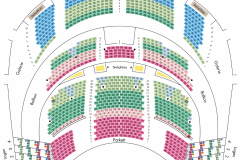Der Zarewitsch
Mo | Tu | We | Th | Fr | Sa | Su |
Der Zarewitsch
Operetta by Franz Lehár
In German language with German and English surtitles
No Pause
The young successor to the throne Aljoscha is unhappy and tormented by loneliness. He avoids contact with women, yet he longs for another person. Eventually, he meets a young man – who, in Lehár’s version, is a girl in disguise. However, for Dutch director and artist Steef de Jong, the situation is more complex … He relocates the story, originally set in Russia, to a more universal fairytale world, focusing entirely on the slowly blossoming love story. He uses beautiful drawings and animations, filmed live and projected, creating a work of art that blends operetta and animated film, capturing the melancholy of Lehár’s music while also adding humor and lightness.
Synopsis
The plot of Der Zarewitsch is loosely based on a true story: the self-imposed exile of the son of Peter the Great, Alexei, who shirked his father's command to become a monk or take interest in the military by running away to his brother-in-law's kingdom, the Holy Roman Empire, with his Finnish mistress disguised as a page. The couple spent two years in hiding until Alexei was compelled by his father to return. His father was paranoid that Alexei was conspiring against him and ultimately Alexei ended up being imprisoned and tortured. The Russian senate convicted him of conspiring against his father and he was sentenced to death. He died due to ill health before he could be executed, most likely resulting from the poor treatment he received while imprisoned.
Reichert's libretto differs on several points from the life of Alexei. First, he changed the story so that the young girl, Sonja, is first seen disguised as a male Circassian dancer. When the Tsarevich runs away with Sonja he believes that she is a boy adding what Richard Traubner of Opera News called an "underlying homosexual frisson" to the operetta.[This quote needs a citation] Eventually the young prince discovers that Sonja is in fact a girl disguised as a boy. The two fall in love and escape to Naples. A further major difference is that the operetta does not have such a tragic ending, though it is not exactly happy either. Eventually the Zarewitsch learns that his father has died and he knows his relationship cannot continue with Sonja as he is now the Tsar. The operetta ends with a "bittersweet royal–commoner parting".
Program and cast
Direction, stage and costumes: Steef de Jong
Dramaturgy: Jürgen Bauer
Choir director: Roger Díaz-Cajamarca
Choir director: Holger Christian
Musical direction: Luka Hauser
Der Zarewitsch: David Kerber
Sonja: Hedwig Ritter
Ivan, Secretary to the Tsarevich: Martin Enenkel
Masha, his wife: Juliette Khalil
by and with: Steef de Jong
Volksoper Vienna
Public transport:
Underground line U6
Trams 40, 41, 42
Bus 40A
Stop "Währinger Straße / Volksoper"
A taxi stand is located at Währinger Gürtel.
Parking garages in WIFI and AKH
The Volksoper is Vienna’s main stage for operetta, opera, musicals and ballet, offering sophisticated musical entertainment. Colourful, eclectic and full of vitality, it is the only theatre dedicated to the genre of operetta.
Operetta belongs to Vienna and Vienna installed it at the home of operetta, Volksopera Vienna, which thereupon became the leading operetta house in the world. First class singers, actors and dancers together with a versatile orchestra cunjure up a musical firework display every evening.
Johann Strauss, Franz Lehár, Emmerich Kálmán wrote their world famous beloved melodies for operettas such as “The Fledermaus”, “The Merry Widow” and “The Csárdás Princess”. A visit to at least one of these operettas at the Volksopera Vienna is a must for every visitor to Vienna!
Also performed are operas from the 18th, 19th and 20th centuries, as well as classic musicals and ballet. In addition, the Volksoper has a fifth longstanding and proven speciality: it stages soirées, cabaret and burlesque performances under the name of “Volksoper Spezial”.
In the repertory theatre, which seats 1,337 persons, some 300 performances of around 35 different productions are staged every year between September and June.

 EN
EN DE
DE IT
IT FR
FR ES
ES RU
RU JP
JP RO
RO
 Seating plan
Seating plan